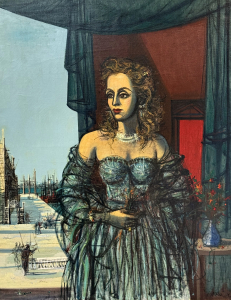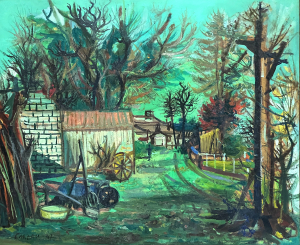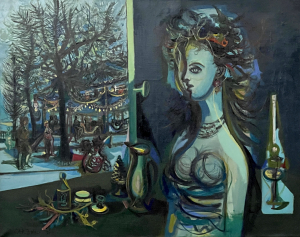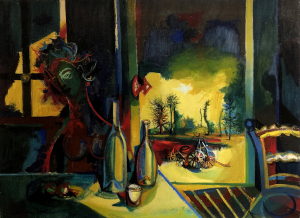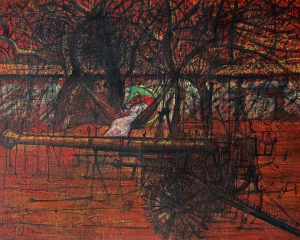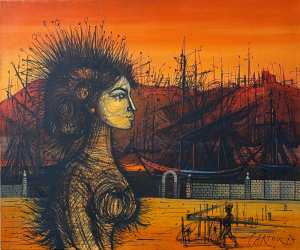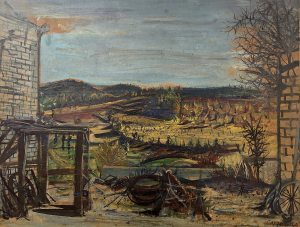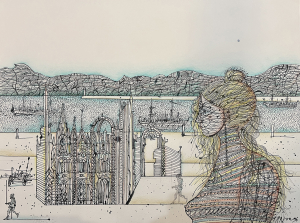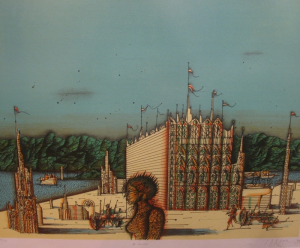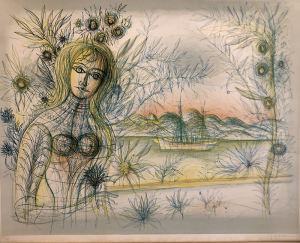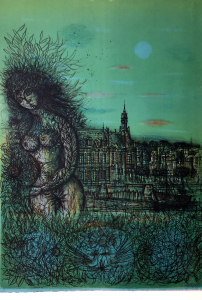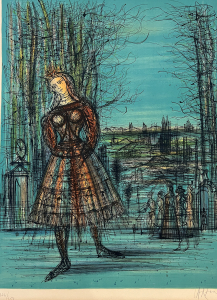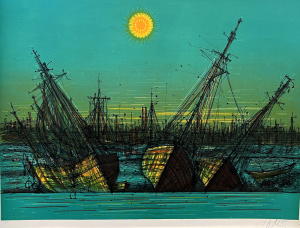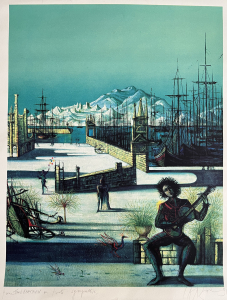
CARZOU
Jean Carzou (1907 - 2000)
Carzou was born in Aleppo, Syria
1919 Moved to Cairo, Egypt
1924 Finished Kalousdian Armenian School in Cairo, obtained an American scholarship to go and study in Paris
1929 Graduated from the School of Architecture in Paris. As an autodidact, attended the Montparnasse Art Academy (La Grande Chaumière) in Paris, France
1930 First exhibition at the Independent Salon, Paris, France
Since 1930 Takes part in the exhibitions of the Union of Armenian Artists "Ani", Paris, France
1939 First personal exhibition at Galerie Contemporaine, Paris, France
Since 1939 Had more than a hundred personal exhibitions in France and abroad
Since 1941 Takes part in the exhibitions of the Autumn Salon, Paris, France
1952 Created costumes and sceneries for the opera-ballet "The Gallant Indians" for Opèra de Paris, France
1953 An exhibition of his Venetian landscapes was open in the gallery David and Garnier, Paris, France
1953 Created the settings and costumes of "The Wolf" ballet for Paris Opera Ballet Roland Petit, which was produced again by La Scala de Milan (1963)
1954 Created stage-sets and costumes of "Giselle" ballet for Opèra de Paris, France
1955 Created costumes and sceneries of "Athalie" for la Comèdie-Française in Paris, France
1957 Created his famous antiwar series "The Apocalypse" in Paris, France
1958 Illustrated the book "France" by A. Morua
1959 The creation of his "Earthly Paradise" series
1959 Personal exhibition in New York, USA
1964 Illustrated E. Hemingway's novel "A Farewell to Arms"
1965 Illustrated "Notebooks" by A. Camus
Till 1966 Had about 50 personal exhibitions in Cairo, Alexandria, Beirut (1950), Geneva (1951), Brussels (1953), London (1954), Frankfurt (1966), many times in Paris and in other big centers of France
1966 First personal exhibition in Yerevan, Armenia
1969 Illustrated E. Poe's "The Murders in the Rue Morgue"
1976 Carzou became the first living artist to have his work "Distant Princess" appear on a French postage stamp
1977 Was elected a member of the French Academy of Fine Arts
1983 Personal exhibition in Yerevan, Armenia
1991 The Church of Manosque (Provence, France) in which he had decorated the chapel became Carzou Foundation
1994 Creation of "To Versailles" series
2007 Personal exhibition devoted to the 100th anniversary of his birth was held at the National Gallery, Yerevan, Armenia
2013 French – Armenian Art at Arame Art Gallery, Yerevan, Armenia
2014 A Unique Art Show Featuring the Works of French-Armenian Artist Jean Carzou at Arame Art Gallery, Yerevan, Armenia
Titles and Awards
1930 In an exhibition of French painters Carzou's painting "Old Gardens of Alcazar" wins the first prize
1949 Was awarded the Hallmark prize for his painting "The Shepherd and the Mage"
1951 Was awarded the Hallmark prize
1954 Won the Grand Prize of Ile de France for his "Derelict castle at Bougival"
1955 Was awarded the Hallmark prize
1955 Won the Grand Prize in the International Biennale in Tokyo, Japan
1956 Knight of the French Legion of Honor
1958 Was awarded the Grand Prize "Europe" at the Biennale in Bruges, Belgium
1958 Commander of France's Order of Arts and Letters
1977 Commander of France's National Order of Merit
1980 Was awarded the prize of Martiros Sarian in Yerevan, Armenia
In the sphere of different groups, absorbed in the mania of modernism and flows of modern art Carzou searched for and found «the modern» in his identity. His being an architect, that is the soul that searches for beauty, played an important role in his life. The content and means of expression of Carzou's art are linked to contributions of classical art and have spiritual connection with such masters of past as Kahlo, Claude Lorrain, Watteau, Ingres. In his paintings reality transforms into zealous and graceful connection of lines, imagined worlds, where poetical feelings and lyrical emotions throb, that touch upon the eternal beauty of life and nature. In this regard Carzou is the inheritor of fineness and simple beauty that gives original gleam and warmness to French art.
At first sight Carzou's paintings seem to be a sheaf of lines. But we can clearly see, that they represent cities, buildings, forests, ports, human figures. The line is the main means of expression in Carzou's art.
Shahen Khachatrian
Art critic
Carzou, nobody could paint better than you the inhuman face of the world, the dead surface of the Planet, where horror is reflected as in a mirror.
Art critic Robert Rey on Carzou’s “The Apocalypse” series
Writing an article about the genius Carzou was on my mind for a while. The first reason for me to want to write about him was that he was a famous personality and of Armenian origin. Carzou started his painting career with experiments in abstract art against a black background and produced surrealist compositions under the influence of Cubism. He abandoned these after 1938, taking up color and establishing his own style.
In a 1955 survey Carzou was acclaimed one of the ten major painters of his generation. Zouloumian was also an illustrator of literary publications of authors like Jules Verne, Andre Maurois, Audiberti, Albert Camus, Shakespeare, Rimbaud, T.S. Eliot, Edgar Allan Poe and Hemingway.
This great multi-talented artist was survived by his son Jean-Marie, who is a well-known writer and has kept the Armenian case alive by writing a book on the Armenian Genocide.
H. J. Sebouhian
Art critic

